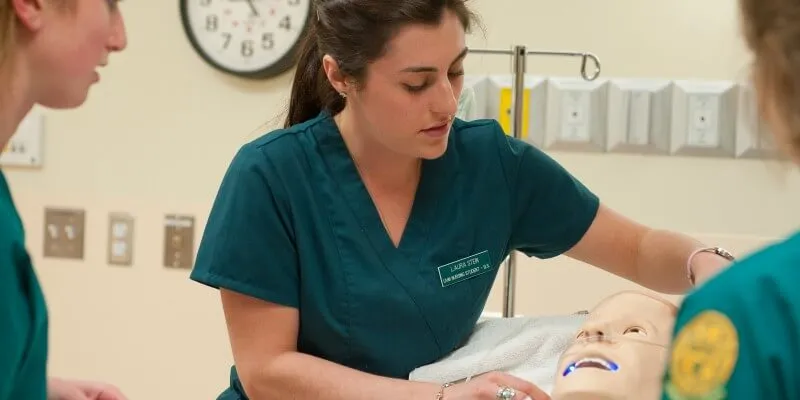The patient moaned as a health care provider pressed on his abdomen and rolled him onto his side. She asked him to rate his pain, took his pulse and listened to his breathing through a stethoscope. When she suggested he take medication for the pain, he resisted and expressed fear that taking medication would prolong his stay in the hospital.
Moments later, the scenario repeated with the same patient, but a different health care provider. And it happened again, and again, until all the first year nursing students finished their respiratory assessment tests. After each session, the patient role-player – or “standardized patient” – and Associate Professor of Nursing Marcia Bosek gave the students feedback on their performance, pointing out what went well and where to improve.
This was a typical day in the Clinical Simulation Laboratory in Rowell Hall at the University of Vermont. A collaborative effort of the UVM College of Nursing and Health Sciences, Larner College of Medicine, and The University of Vermont Medical Center, the “Sim Lab” serves as a centralized hub in the training of health care professionals with the ultimate goal of improving patient safety and quality care. It is one of only 10 simulation centers in the country to achieve full accreditation from the Society for Simulation in Healthcare.
Simulation is a technique that creates a representation of a real event for the purpose of experiential practice, learning, testing, evaluation and understanding of systems. Using simulation, learners address critical skills including procedures, dynamic decision-making, and communication.
“I feel like my brain grew more in those 15 minutes than in six hours of classes,” said Shayne Galloway, a graduate nursing student in Bosek’s clinical group. “You have your clinical knowledge, bedside manner, patient communication, critical thinking skills. But when you walk in that room, it’s a real person and you have to put all the pieces together. It’s daunting, and a little stressful, but it’s a safe environment.”
“Learners apply what they have learned in a true-to-life patient care situation, and they're doing it in an environment where there’s no risk of harm to the patient, prior to going into clinical experiences,” said Nancy LeMieux, Clinical Instructor and simulation laboratory faculty leader in nursing. “What I really like about it is we always debrief after caring for a patient. During that time, the students can make sense and develop new understandings.”
Debriefing helps students understand and reflect upon their own personal learning styles, said Galloway. “I’m really focused, I fixate on things, and I forget to think about other parts of a patient. Now that I know that, I’ll be a much better nurse, because I had a chance to falter a bit. We’re encouraged to reflect on how we did, and the standardized patient gives us feedback.”
Along with live standardized patients, simulation-based training uses mannequins and virtual reality for technical procedures ranging from injections and suturing to targeting radiation to delivering babies. It also includes fully staged catastrophic events such as natural disasters, multi-vehicle accidents or mass shootings with many victims.
Standardized patients might exhibit psychiatric illness or mental health issues, and they may include family members to give students practice dealing with distraught relatives and learn how to keep patient- and family-centered care at the center of their focus.
Interprofessional simulations allow students to practice essential teamwork behaviors such as managing high workload and coordinating under stress. For example, simulations involve fourth year medical students and undergraduate nursing students working together to resuscitate a patient in cardiac arrest or practicing therapeutic communication with patients in psychiatric or emotional distress.
“Our grad student clinicians crave meaningful opportunities to put their clinical skills to the test navigate their role as speech-language pathologists (SLPs) on interprofessional teams. Intentionally challenging them to think and act flexibly in simulations is an ideal way to nudge students safely beyond their comfort zones early in their training. "Mistakes" become learning opportunities, and students surprise themselves during post-sim debriefings about how organically they were able to collaborate, listen, and bring a helping voice to the table,” said Danra Kazenski, Clinical Assistant Professor of Communication Sciences and Disorders.
The interprofessional simulations are supported by an endowment by Aline Demers ’55, a practicing nurse, researcher and professor at CNHS, whose bequest was to ensure that simulations involve medical, nursing and other health sciences students to develop their ability to work as a collaborative team, partnering with patients and their families to provide the best possible care.
Demers “was committed to our vision for interprofessional education,” said Patty Prelock, dean of the College of Nursing and Health Sciences. “We are pleased to be collaborating with our colleagues in the Larner College of Medicine and the UVM Medical Center as we work to capitalize on clinical simulation to help achieve our strategic goals in interprofessional education and collaborative practice.”
Beyond teaching skills for individual learners, simulation provides insight into the performance and effectiveness of processes and systems critical to patient safety and patient care. Improving the care sequence within a hospital, for instance, requires an accurate model of the care process simulated against numerous “what if” conditions. These insights help a hospital to properly plan for and manage both normal and abnormal conditions, resulting in better care for patients. The sim lab also provides a workshop for faculty to learn how to design scenarios and use simulation as an educational strategy.
For students, practicing with live role-players lab boosts confidence and provides a head start to clinical skills. “No one comes into nursing school knowing how to be a real nurse,” said Galloway. “I’ll be better prepared going to my clinical site, because I had a chance to act like a real nurse.”
